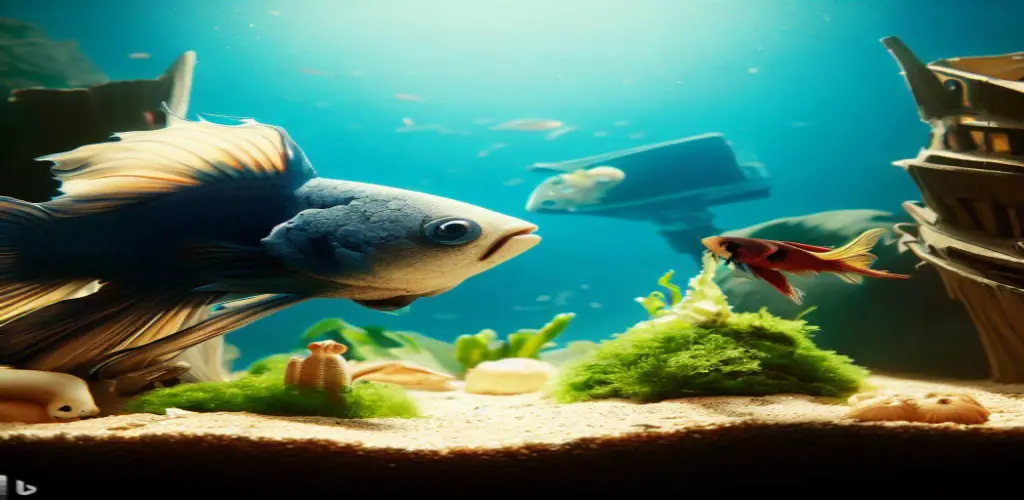Fishkeeping can be a relaxing and rewarding hobby. However, it requires careful planning, research, and attention to detail. One of the critical factors to consider when keeping fish is their compatibility with other species in the same tank. Plecostomus and betta fish are popular species that many people like keeping in their aquariums. But can they live together? Can a Plecostomus live with a Betta fish? In this article, we will delve into the compatibility, behavior, and habitat requirements of these two fish species to determine if they can coexist in the same tank.
What is a Plecostomus?
Plecostomus, commonly known as “plecos,” are freshwater catfish native to South America. They have a unique appearance characterized by a large head, an armored body, and a sucker mouth. Plecos can grow up to two feet long and have a lifespan of 10-15 years with proper care. These fish are bottom-dwellers known for their ability to help keep the tank clean by consuming algae and other debris.
There are various species of Plecostomus, each with its unique characteristics. The Bristle nose Pleco, for instance, is a smaller species, growing to about 4-6 inches, making it more suitable for smaller tanks. On the other hand, the Common Pleco can grow much larger and may require a more spacious aquarium.
What is a Betta Fish?
Betta fish, or Siamese fighting fish, are popular freshwater fish native to Southeast Asia. Bettas are small, colorful fish known for their aggressive behavior towards other males of the same species. Male bettas have long, flowing fins and are more colorful than females. Bettas can live up to three years with proper care.
Bettas are labyrinth fish, meaning they have a specialized labyrinth organ that allows them to breathe air directly from the surface, in addition to using their gills. This unique adaptation enables them to survive in low-oxygen environments where other fish might struggle. Can a Plecostomus live with a Betta fish? This question often arises due to the unique needs and behaviors of each species.
The Behavior of Plecostomus and Betta Fish
Plecostomus are generally peaceful and solitary fish. They are more active at night and spend most of their time hiding in caves or under rocks during the day. Plecos are also known to be territorial towards other bottom-dwelling fish, especially if the tank is not large enough.
Betta fish, on the other hand, are territorial and aggressive towards other males of the same species. However, they can coexist peacefully with other fish species that are not aggressive towards them and do not have long, flowing fins that resemble other bettas. Female bettas are generally less aggressive than males and can sometimes be kept in sorority tanks with other females.
Habitat Requirements of Plecostomus and Betta Fish
Plecostomus Habitat Requirements
Plecostomus prefer tanks with plenty of hiding places, such as caves and driftwood. They also require a well-filtered tank with a high oxygen content. Plecos thrive in water with a temperature range of 72-82°F and a pH between 6.5-7.5. It is crucial to provide a varied diet for plecos, including algae wafers, vegetables like zucchini and cucumber, and occasional protein sources like shrimp pellets.
Betta Fish Habitat Requirements
Bettas prefer tanks with plants and other objects to hide behind and a heater to maintain a consistent water temperature between 76-82°F. They thrive in slightly acidic to neutral water with a pH range of 6.8-7.5. Betta tanks should also have gentle water flow, as strong currents can stress these fish. Live plants like java fern, anubias, and floating plants like water lettuce can provide a natural and comfortable environment for bettas. It is very important to know how to care for a Betta Fish before having a tank mate with it.
Can Plecostomus and Betta Fish Live Together?
The short answer is it depends. In general, keeping Plecostomus and betta fish together is not recommended. While plecos are generally peaceful, they are also known to be territorial towards other bottom-dwelling fish, and their large size can intimidate bettas. Betta fish are also known to be aggressive towards fish with long fins, which can result in the pleco’s fins being nipped or damaged.
Risks of Keeping Plecostomus and Betta Fish Together
Keeping Plecostomus and betta fish together can be risky for both species. If the tank is not large enough, the plecos can become territorial and aggressive toward the bettas, leading to stress and injury. Additionally, plecos produce a lot of waste, which can negatively impact the water quality in the tank. This can harm both plecos and bettas, as poor water quality can lead to disease and even death.
How to Set Up a Plecostomus and Betta Fish Tank?
Setting up a tank with Plecostomus and betta fish can be challenging, as these two species have different requirements for their environment. However, it is possible to create a suitable home for both fish with careful planning and attention to detail. Here are some steps you can follow:
- Choose the right tank size: A tank size of at least 20 gallons is recommended for a community tank with Plecostomus and betta fish. This will provide enough swimming space and also ensure that the water parameters are stable.
- Decorate the tank: Plecostomus are known for their love of hiding spots and caves, so provide plenty of hiding places for them. This can be done by adding driftwood, rocks, and caves to the tank. On the other hand, betta fish prefer open spaces and lots of plants to hide in. Live plants such as java fern and anubias can provide both fish a natural environment to thrive.
- Choose the right filter: Plecostomus are messy eaters and produce a lot of waste, so a good quality filter is essential. A hang-on-back or canister filter is recommended for a tank with Plecostomus and betta fish.
- Monitor water parameters: Both species have different requirements when it comes to water parameters. Plecostomus prefer slightly acidic water with a pH of around 6.5-7.5, while betta fish prefer slightly alkaline water with a pH of around 7.0-8.0. Make sure to test the water regularly and adjust accordingly.
- Feed the fish: Plecostomus are herbivores and require a diet that is high in fiber. Offer them a variety of vegetables such as zucchini, cucumber, and spinach. Betta fish are carnivores and require a diet that is high in protein. Feed them a good quality pellet or flake food and supplement their diet with frozen or live food such as bloodworms or brine shrimp.
- Introduce the fish slowly: When introducing new fish to the tank, it is essential to do so gradually to avoid stress and potential aggression. Keep the lights off and float the bags containing the new fish in the tank for at least 20-30 minutes before releasing them.
- Monitor the fish: Monitor the fish for signs of stress, disease, or aggression. Plecostomus can be territorial and harass other fish, so provide plenty of hiding places for the other fish in the tank.
By following these steps, you can create a suitable home for Plecostomus and betta fish in the same tank. Can a Plecostomus live with a Betta fish? Yes, but it requires careful consideration and planning.
Additional Tips for Keeping Plecostomus and Betta Fish Together
If you still want to keep Plecostomus and betta fish together, there are some things you can do to increase your chances of success. Here are some additional tips:
- Ensure ample hiding spots: Increase the number of hiding places and shelters in the tank to reduce territorial disputes. This can include more plants, caves, and decorations that both fish can use.
- Maintain optimal water quality: Regular water changes are crucial to keep ammonia and nitrate levels low. Plecos produce a significant amount of waste, which can quickly deteriorate water quality if not managed properly.
- Observe fish behavior: Pay close attention to the interactions between the Plecostomus and the betta fish. If you notice any signs of stress, such as clamped fins, hiding, or aggression, consider separating the fish.
- Consider tank mates carefully: If you plan to add other fish to the tank, choose species that are known to be compatible with both Plecostomus and betta fish. Avoid fish that are known fin-nippers or highly aggressive.
- Use a tank divider: In some cases, using a tank divider can help keep the Plecostomus and betta fish in the same tank without direct interaction. This allows both fish to share the same water conditions while having their separate spaces.
Conclusion
In conclusion, while Plecostomus and betta fish can technically live together, it is not recommended due to the risks involved. Plecos can be territorial and aggressive towards other fish, and their large size can intimidate bettas. Additionally, plecos produce a lot of waste, which can negatively impact the water quality in the tank. Can a Plecostomus live with a Betta fish? The answer is yes, but only with careful planning, monitoring, and consideration of both species’ specific needs. If you decide to keep them together, follow the guidelines outlined in this article to ensure a harmonious and healthy environment for both fish species.
FAQs
Can Betta fish live with other fish?
Yes, betta fish can coexist peacefully with other fish species that are not aggressive toward them, such as neon tetras, guppies, and corydoras.
Can plecos live with other fish?
Yes, plecos can coexist peacefully with other non-aggressive fish species, such as tetras, gouramis, and danios.
Can bettas live in a small tank?
No, bettas require a tank of at least 5 gallons to thrive. A larger tank is recommended to provide ample swimming space and to accommodate other fish if desired.
Do plecos need a heater?
Yes, plecos require a heater to maintain a consistent water temperature between 72-82°F.
Can plecos and bettas live together in a community tank?
Plecos and bettas can live together in a community tank if the tank is large enough and there are plenty of hiding places for both fish. However, it is essential to closely monitor their behavior and separate them if necessary to avoid conflicts.
By carefully considering the needs and behaviors of both plecostomus and betta fish, you can create a harmonious and healthy environment for your aquatic pets. Always prioritize the well-being of your fish and be prepared to make adjustments as needed to ensure their compatibility and happiness in the shared tank.



